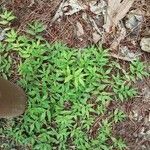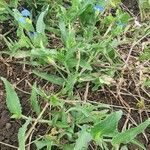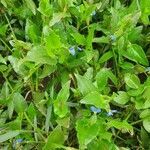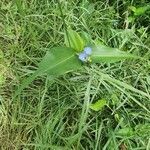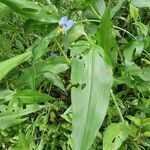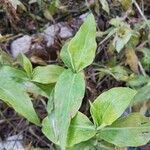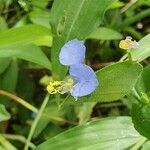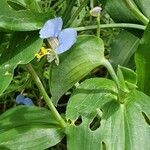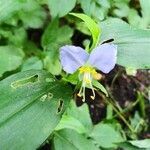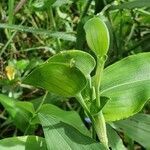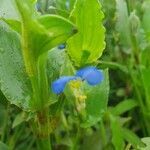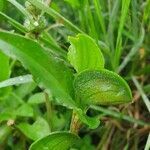Herbs, perennial or annual, spreading. Stems decumbent to scandent. Leaves: blade narrowly lanceolate to lanceolate-oblong, lanceolate-elliptic or ovate, 1.5--14 × 0.5--3.3 cm, margins scabrous, apex acute to acuminate, glabrous. Inflorescences: distal cyme 1--several-flowered, usually exserted; spathes solitary, bright green, without contrasting veins, pedunculate, usually distinctly falcate, (0.5--)0.8--4 ´ 0.4--1.2(--1.4) cm, margins distinct, glabrous or scabrous, sometimes also sparsely ciliate or ciliolate basally, apex usually acuminate, usually glabrous or nearly so; peduncles 0.5--2(--4) cm. Flowers bisexual and staminate; petals all blue (rarely all lavender), proximal petal smaller; medial stamen anther connective usually with transverse band of violet; staminodes 2--3; antherodes yellow, medial often absent or vestigial, cruciform. Capsules 3-locular, 2-valved, 4--6.3 mm. Seeds 5 (or less through abortion), brown, 2--2.8(--3.2) ´ 1.4--1.8 mm, deeply reticulate.
Fibrous-rooted annual, diffusely branched, decumbent and rooting from the lower nodes, to 1 m; lf-blades lanceolate, the larger 3–8(–11) × 1–1.5(–2) cm; sheaths 0.5–1 cm; spathe (folded) semicordate and ± falcate, 1.5–2.5 cm, nearly as wide, acute or short-acuminate, glabrous or finely ciliate, its margins free, its stalk 1–2 cm; larger spathes usually with a 1–few-fld upper cyme in addition to the well developed lower one; blade of upper pet 6–8 mm; lower median pet blue; anthers 5 or 6 (2 or 3 sterile); fr 3-locular, the lower locules each 2-seeded, the upper one 1-seeded; seeds of the lower locules 2–2.8(–3.2) mm, deeply reticulate; 2n=28–60. Wet woods and river-banks; native to the Old World, only intr. in N. Amer., where mainly in se. U.S., n. sometimes to Del., O., Ill., Minn., and Kans.
Annual or perennial hygrophilous spreading herbs sometimes covering large stretches of ground, creeping stems forming short, erect side branches, rooting at nodes. Leaves linear to ovate or oblong, 50-140 x 15-25 mm, apex acuminate, glabrous or puberulous, margins often encrusted with white pustules. Spathes pedunculate, folded, broad and acute to long and attenuate. Upper cyme exserted on an erect, glabrous or pubescent peduncle, (l-)2(-3)-flowered, rarely aborted; lower peduncle pubescent, with 3-8 bisexual flowers. Sepals white, membranous. Petals blue or white. Stamens with yellow, red, blue or black filaments and anthers. Capsule quadrate; 2 ventral locules 2-seeded, dorsal locule indehiscent, fusiform, 1-seeded, or empty; seeds reniform, reticulate with tuberculate hexagonal areoles.
A small leafed, straggling herb, with blue flowers. It continues to grow from year to year. It can grow to 1 m long. The stems are weak. The stem is fleshy, and it roots at the nodes. The leaves are alternate and sword shaped. They are 4-10 cm long. They have short stalks and a stem clasping sheath. The flowers are blue and 2.5-3 cm across. One of the 3 petals is smaller than the others. The seeds have fine patterns on one side. They are angular and about 2 mm long.
Perennial, spreading herb, heliophyte, 0.10-0.87 m high. Leaves linear, 50-140 x 15-25 mm, apex ± acuminate, margins may be encrusted with white pustules. Spathe pendunculate, acute to attenuate. Inflorescence a 1-3-flowered cyme. Flowers: petals blue or rarely white. Stamens with yellow, red, blue or black filaments and anthers. Flowering time Nov.-May. Fruit a quadrate capsule, 2 ventral locules 2-seeded, dorsal locule indehiscent, fusiform, 1-seeded or empty.
Weak, creeping, subsucculent annuals, glabrous throughout. Leaves ovate-or oblong-elliptic, obtuse or acute, sessile or subsessile, 1-3 cm. long; sheaths 0.5-1.0 cm. long. Inflorescence terminal, the spathe foliaceous, conduplicate, ovate-cordate, open and rounded at the base. Flowers few, pale blue; sepals 0.2-0.25 cm. long; 2 posterior petals narrowly clawed, 0.3-0.5 cm. long, the anterior rudimentary or obsolete.
